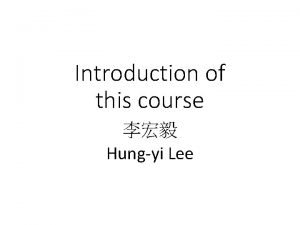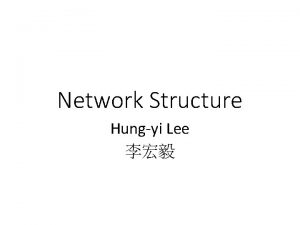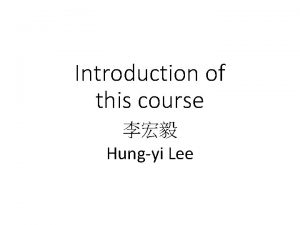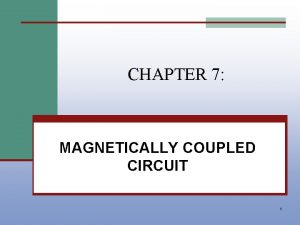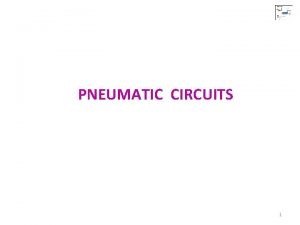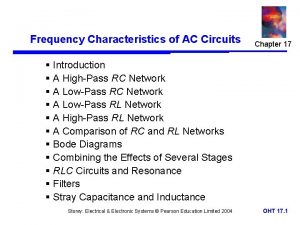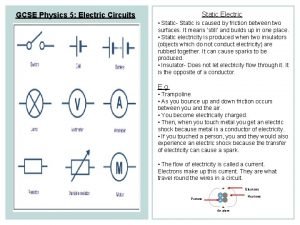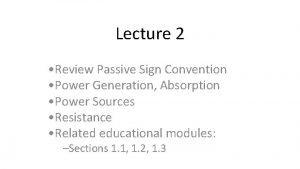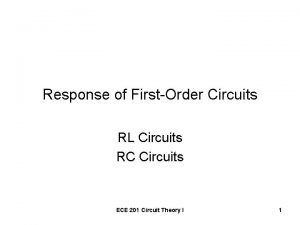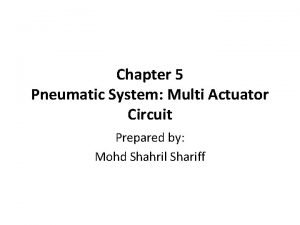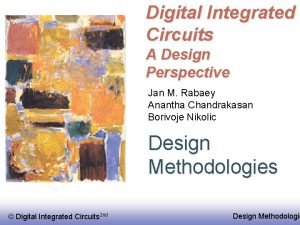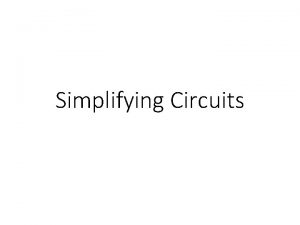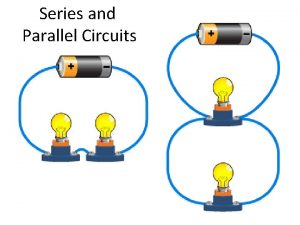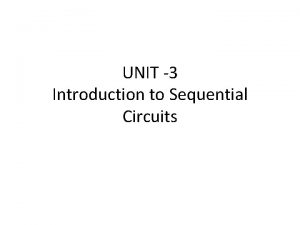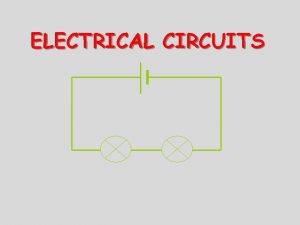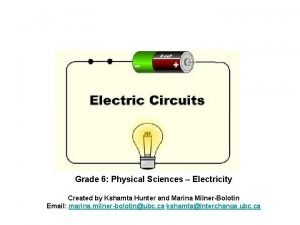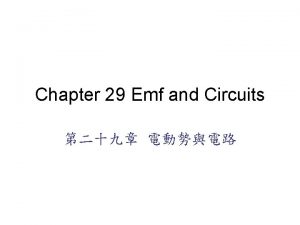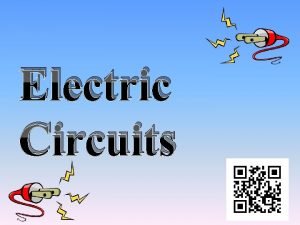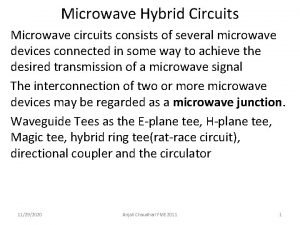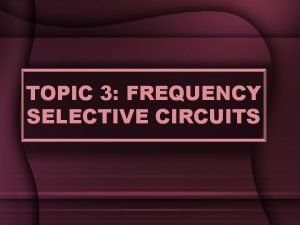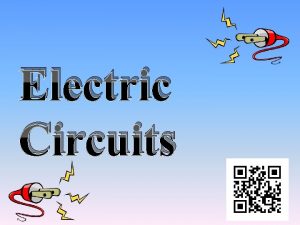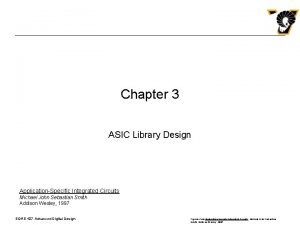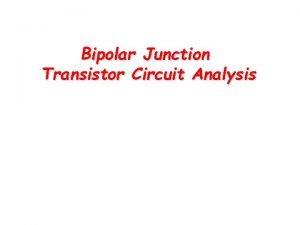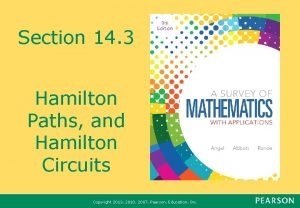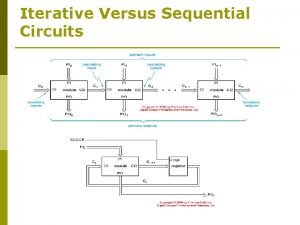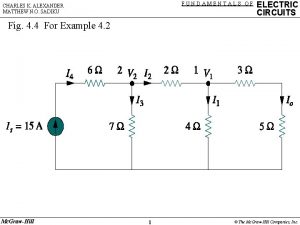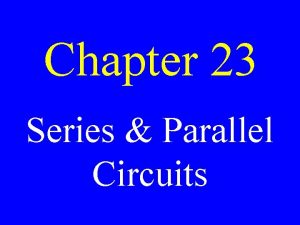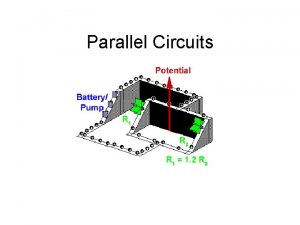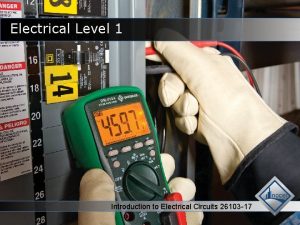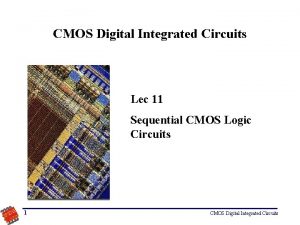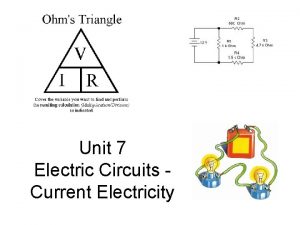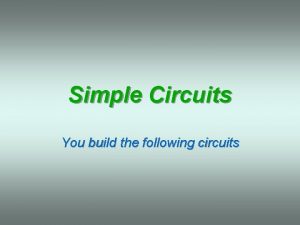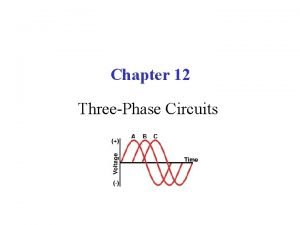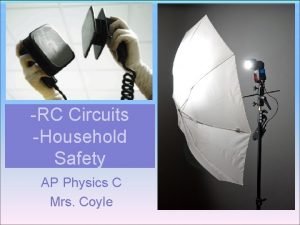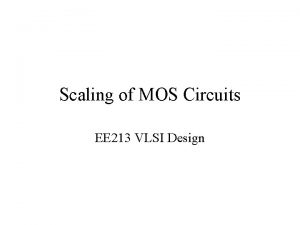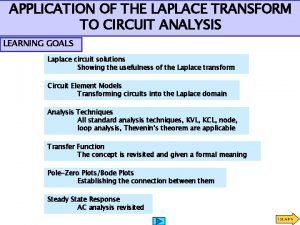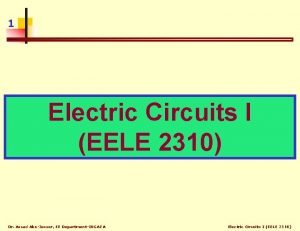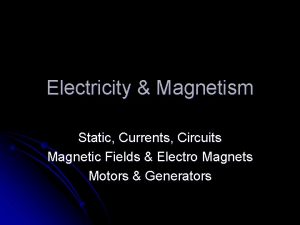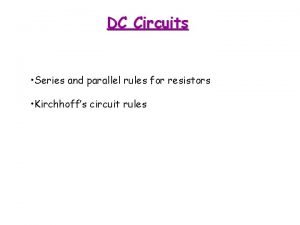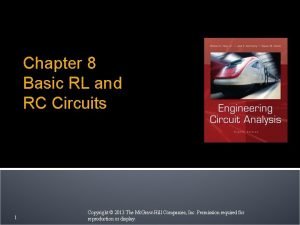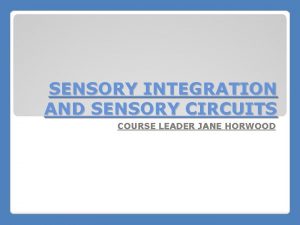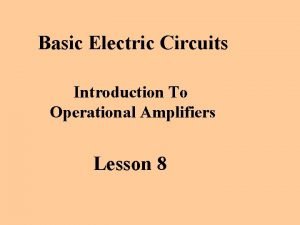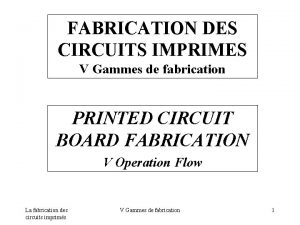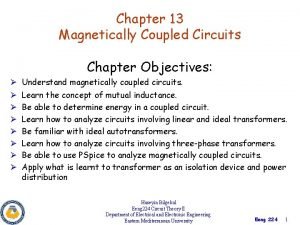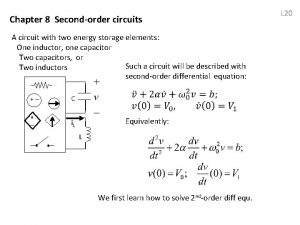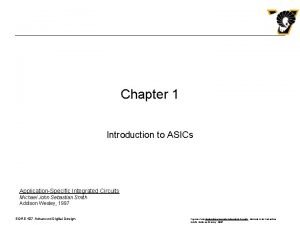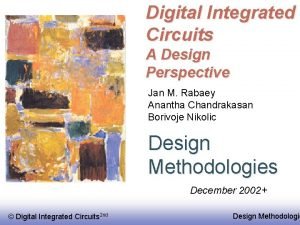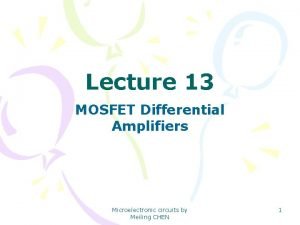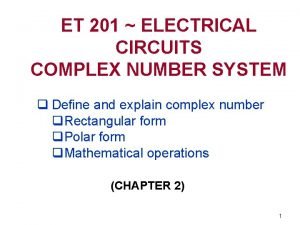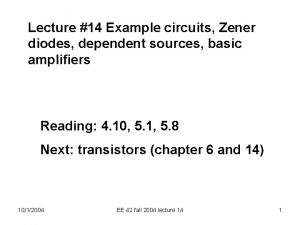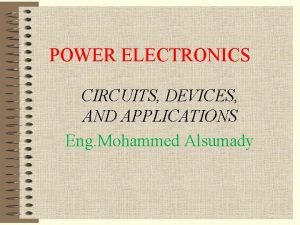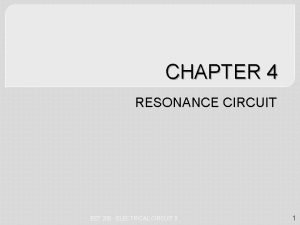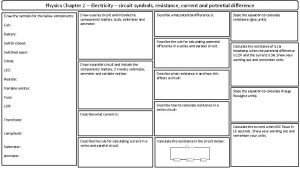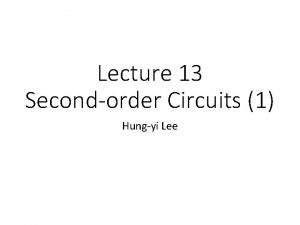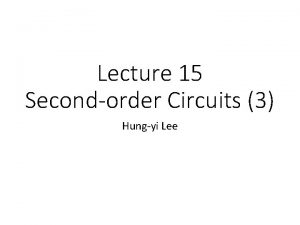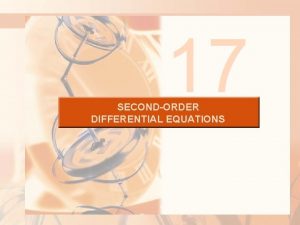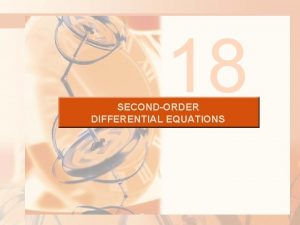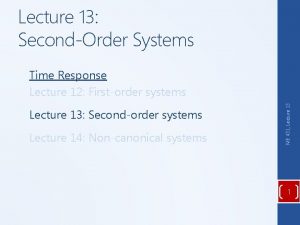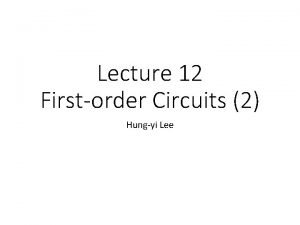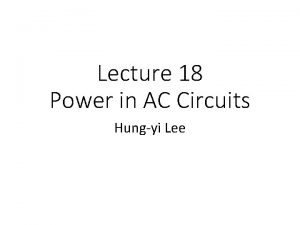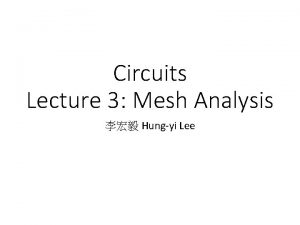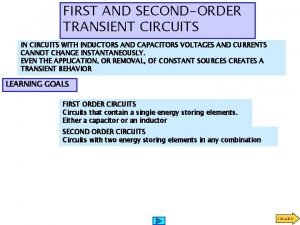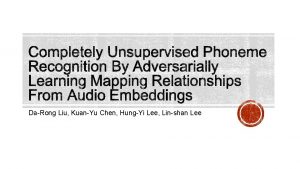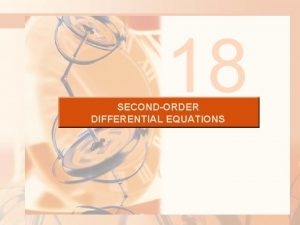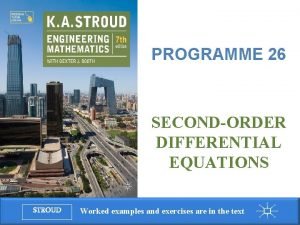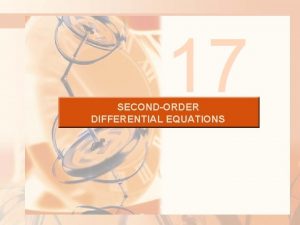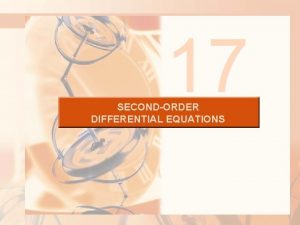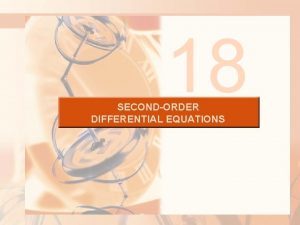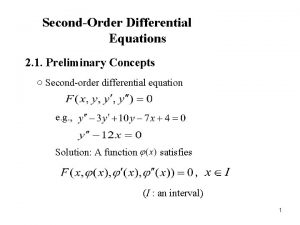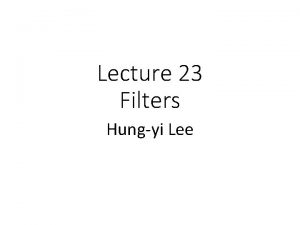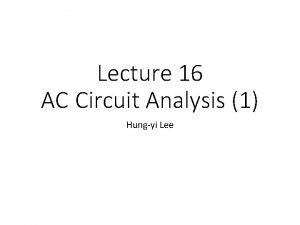Lecture 14 Secondorder Circuits 2 Hungyi Lee SecondOrder






































































- Slides: 70

Lecture 14 Second-order Circuits (2) Hung-yi Lee

Second-Order Circuits Solving by differential equation

Second-order Circuits • Steps for solving by differential equation • 1. List the differential equation (Chapter 9. 3) • 2. Find natural response (Chapter 9. 3) • There are some unknown variables in the natural response. • 3. Find forced response (Chapter 9. 4) • 4. Find initial conditions (Chapter 9. 4) • 5. Complete response = natural response + forced response (Chapter 9. 4) • Find the unknown variables in the natural response by the initial conditions

Review Step 1: List Differential Equations

Review Step 2: Natural Response Real Overdamped Critical damped λ 1, λ 2 is Complex Underdamped Undamped

Fix ω0, decrease α The position of the two roots λ 1 and λ 2. α=0 Undamped

Example 9. 11 Natural response i. N(t):

Example 9. 11 Natural response i. N(t): Forced response i. F(t)=0 Complete response i. L(t): Two unknown variables, so two initial conditions.

Example 9. 11 Initial condition short 30 V open

Example 9. 11

Example 9. 11 Textbook:

Example 9. 12 Natural response v. N(t): Forced response v. F(t):

Example 9. 12 Initial condition: short 0 V open

Example 9. 12 Initial condition: Different R gives different response

Example 9. 12 Overdamped: Initial condition:

Example 9. 12 Critical damped: Initial condition:

Example 9. 12 Underdamped: Initial condition:

Example 9. 12 31. 58 cos x sin x

Example 9. 12

Non-constant Input • Find vc(t) for t > 0 when v. C(0) = 1 and i. L(0) = 0

Non-constant Input Natural response v. N(t): Forced response v. F(t):

Non-constant Input Initial Condition:

Non-constant Input

Second-Order Circuits Zero Input + Zero State & Superposition

Review: Zero Input + Zero State y(t): voltage of capacitor or current of inductor = = y(t) = general solution + special solution = natural response + forced response Set sources to be zero y(t) = state response (zero input) + input response (zero state) Set state vc, i. L to be zero = state response (zero input) + input 1 response + input 2 response …… If input = input 1 + input 2 + ……

Example 1 (pulse) State response (Zero input): Find v. C(t) for t>0

Example 1 (pulse) State response (Zero input): Find v. C(t) for t>0

Example 1 (pulse) Input response (Zero State): Find v. C(t) for t>0 (set state to be zero) … - … =

Example 1 … …

Example 1 Input response (Zero State): … - … =

Example 1 Input response (Zero State): … - … =

Example 1 Input response (Zero State) State response (Zero input)

Example 1 – Differential Equation (pulse) Find v. C(t) for t>0 Assume 30 s is large enough

Example 1 – Differential Equation

Example 1 – Differential Equation

Example 2 Find v. C(t) for t>0 State response (Zero input): Changing the input will not change the state (zero input) response.

Example 2 Find v. C(t) for t>0 Input response (Zero state): Input (set state to be zero) What is the response? 4 methods

Example 2 – Method 1 for Zero State Natural Response: Forced Response:

Example 2 – Method 1 for Zero State

Example 2 – Method 2 for Zero State Find the response of each small pulse Then sum them together

Example 2 – Method 2 for Zero State … - … =

Example 2 – Method 2 for Zero State Consider a point a value of the pulse at t 1 is a

Example 2 – Method 2 for Zero State Consider a point a value of the pulse at t 1 is

Example 2 – Method 2 for Zero State We can always replace “a” with “t”.

Example 2 – Method 3 for Zero State … … The value at time point a a … …

Example 2 – Method 3 for Zero State

Example 2 – Method 4 for Zero State Source Input: Input (Zero State) Response Source Input: … Input (Zero State) Response

Example 2 – Method 4 for Zero State

Example 2 Method 2: Method 3: Method 4:

Example 2

Example 2 – Checked by Differential Equation Find v. C(t) for t>0

Example 3 Find v. C(t) for t>0 How to solve it? I will show to solve the problem by Method 1: Differential equation Method 2: Integrating Step Responses Method 3: Differentiate the sources

Example 3 – Method 1: Differential Equation Find v. C(t) for t>0

Example 3 – Method 1: Differential Equation

Example 3 – Method 2: Integrating Step Responses … … … The value at time point a If a > 30 a a If a < 30 Integrating from 0 to a If a > 30 Integrating from 0 to 30

Example 3 – Method 2: Integrating Step Responses

Example 3 – Method 3: Differentiate the sources Response:

Example 3 – Method 3: Differentiate the sources Response:

Example 3 – Method 3: Differentiate the sources Response:

Announcement • 11/12 (三) 第二次小考 • Ch 5. Dynamic Circuit (5. 3) • Ch 9. Transient response (9. 1, 9. 3, 9. 4) • 助教時間:週一到週五 PM 6: 30~7: 30

Homework • 9. 58 • 9. 60

Homework • Find v(t) for t>0 in the following circuit. Assume that v(0+)=4 V and i(0+)=2 A.

Homework • Determine v(t) for t>0 in the following circuit

Thank You!

Homework • 9. 58 • 9. 60

Homework • Find v(t) for t>0 in the following circuit. Assume that v(0+)=4 V and i(0+)=2 A.

Homework • Determine v(t) for t>0 in the following circuit

Appendix

Higher order? • All higher order circuits (3 rd, 4 th, etc) have the same types of responses as seen in 1 st-order and 2 ndorder circuits

 Hungyi
Hungyi Hung yi lee
Hung yi lee Hung-yi lee
Hung-yi lee Hungyi lee
Hungyi lee Lee hung yi
Lee hung yi Advantages of parallel circuit over series circuit
Advantages of parallel circuit over series circuit Magnetically coupled circuits lecture notes
Magnetically coupled circuits lecture notes 01:640:244 lecture notes - lecture 15: plat, idah, farad
01:640:244 lecture notes - lecture 15: plat, idah, farad Single acting cylinder example
Single acting cylinder example An incomplete circuit
An incomplete circuit Solved: ph dincussion ac circuits session 12 q2. low-pass
Solved: ph dincussion ac circuits session 12 q2. low-pass Electrical circuits gcse
Electrical circuits gcse Passive convention
Passive convention Solving first order circuits
Solving first order circuits Cascading method in pneumatics
Cascading method in pneumatics Digital integrated circuits a design perspective
Digital integrated circuits a design perspective Simplifying circuits
Simplifying circuits Series circuit facts
Series circuit facts Three elements of electricity
Three elements of electricity Chapter 35 electric circuits
Chapter 35 electric circuits D flip flop
D flip flop Two types of circuits
Two types of circuits Electric circuits grade 6
Electric circuits grade 6 Basic electrical engineering kulshreshtha
Basic electrical engineering kulshreshtha Emf
Emf Circuits activator answer key
Circuits activator answer key Microwave hybrid circuits
Microwave hybrid circuits Fundamentals of electric circuits chapter 7 solutions
Fundamentals of electric circuits chapter 7 solutions Rl circuit transfer function
Rl circuit transfer function Brass paper fastener conductor or insulator
Brass paper fastener conductor or insulator Neuronal pools
Neuronal pools Frequency selective circuits
Frequency selective circuits Aoi221
Aoi221 Dc analysis of bjt examples
Dc analysis of bjt examples Complete and incomplete circuit
Complete and incomplete circuit Lesson outline lesson 3 describing circuits answers
Lesson outline lesson 3 describing circuits answers American idol
American idol Iterative circuits
Iterative circuits Sedra smith
Sedra smith Charles k. alexander matthew n. o. sadiku
Charles k. alexander matthew n. o. sadiku Chapter 23 series and parallel circuits study guide answers
Chapter 23 series and parallel circuits study guide answers Series-parallel circuit formula
Series-parallel circuit formula Nccer introduction to electrical circuits
Nccer introduction to electrical circuits Non bistable sequential circuits
Non bistable sequential circuits Circuit symbols
Circuit symbols Simple circuits to build
Simple circuits to build Different types of circuits
Different types of circuits Positive phase sequence
Positive phase sequence Ap physics c rc circuits
Ap physics c rc circuits Scaling of mos circuits in vlsi
Scaling of mos circuits in vlsi Circuit analysis laplace transform
Circuit analysis laplace transform Digital integrated circuits a design perspective
Digital integrated circuits a design perspective Lesson 8 comparing series and parallel rlc circuits
Lesson 8 comparing series and parallel rlc circuits Circuits
Circuits A connected graph without any circuit is called
A connected graph without any circuit is called Series circuit rules
Series circuit rules Rc circuits basics
Rc circuits basics Sensory symptoms
Sensory symptoms Electric circuits equations
Electric circuits equations V
V Coupled circuits
Coupled circuits The circuit chapter 8
The circuit chapter 8 Gate array based asic
Gate array based asic Digital integrated circuits
Digital integrated circuits Special-purpose op-amp circuits
Special-purpose op-amp circuits Mosfet differential amplifier gain
Mosfet differential amplifier gain Et 201
Et 201 Zener diode
Zener diode Power electronics circuits devices and applications
Power electronics circuits devices and applications Series and parallel circuits
Series and parallel circuits Physics symbols electricity
Physics symbols electricity

